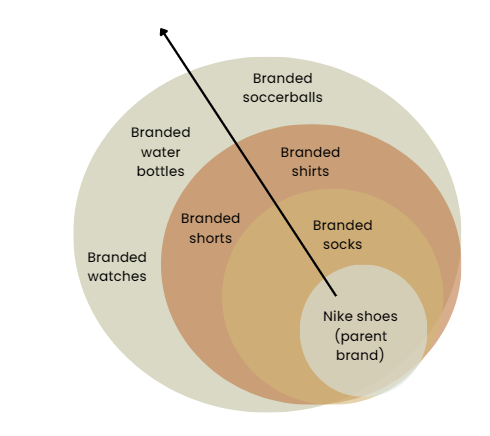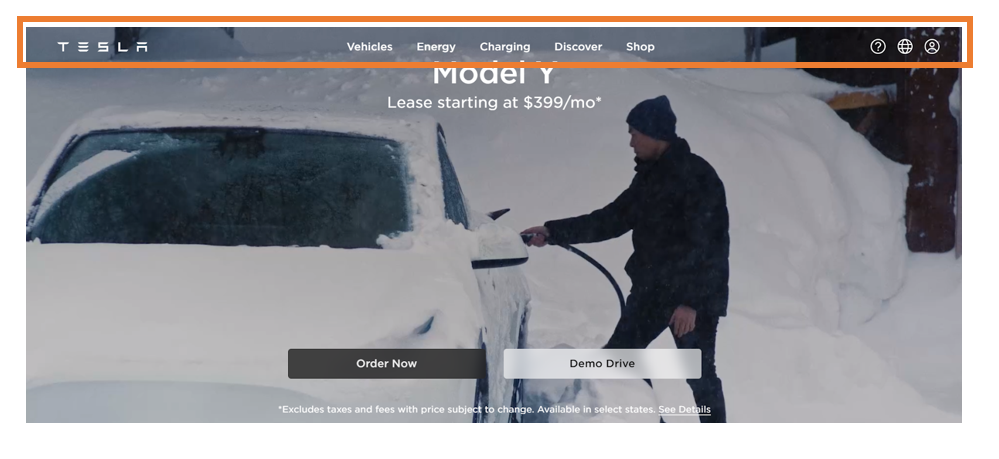Increased market share. Improved brand awareness. A broader customer base. The benefits of a brand extension make the endeavor well worth it if the time and opportunity are right. In fact, almost 70% of new products in the United States represent brand extensions.
But pushing your brand to the next level needs to be grounded in research and guided by strategy. After all, there’s no guarantee that any brand extension will be successful. So here’s what to consider before moving forward.
What is a brand extension?
A brand extension is a marketing tactic that organizations use to expand their offerings or introduce new products.
Take Nike as an example. The company started as an athletic shoe store. But over time, and through many brand extensions, Nike has become the most valuable apparel company in the world.
The diagram below is a hypothetical version of how Nike used brand extensions to become the giant it is today. You’ll see that each extension logically follows a pattern to lead to the next expansion of the brand. If you sell shoes, it makes sense to sell socks. If you sell socks, it makes sense to sell other clothing. And if you sell clothing, it makes sense to sell accessories. While jumping straight from producing shoes to manufacturing watches might not have worked, it’s a rational step after introducing shirts and shorts into the market.

4 common types of brand extensions.
- Line extension: The release of a new product into an existing line. For example, adding a new soda flavor into an already established line.
- Complementary product extension: Similar to a line extension, the release of a companion product. For instance, a company that produces softball gloves may also expand into offering softball bats.
- Company authority extension: Introducing an entirely new product line and relying on brand equity and company loyalty from an existing customer base. For example, Dyson started out manufacturing and selling vacuum cleaners, extended to fans and other household appliances and is now successful in the beauty industry with hair dryers and stylers.
- Customer base extension: Targeting a segment of a company’s customer base and releasing products that cater to those customers to deepen brand loyalty. Look no further than Stanley, the company whose water bottles were largely marketed to men for the first century of the company’s existence — and whose women-focused Galentine’s Day-themed tumblers recently caused a rush at retailers across the country.
Quiz: Are you ready for a brand extension?
Any one of the brand extension types above can help your company capitalize on existing strengths, grow your customer base, and leverage and increase brand equity. In an ideal scenario, your actions will generate what is known as a “halo effect,” where customers have had such positive experiences with your products that they extend the glow of loyalty to new products or services.
But not every brand is ready to reach new markets. In fact, up to 50% of brand extensions fail, indicating that some companies make the decision to expand before they’re ready.
With that in mind, here are five questions to ask when considering whether a brand extension is right for your organization. Write down “yes,” “no” or “maybe” to answer each question.
Yes/no/maybe?
- Do you already have strong parent brand equity among a loyal customer base?
- Do you have the capacity to expand — including enough bench strength to commit a portion of your workforce to the effort?
- Does the proposed extension clearly and logically fit into an already developed product line or customer segment?
- Does the proposed extension meet an unmet customer need? Or is your organization missing an opportunity by not extending into the proposed market?
- Does your brand have core values that customers are drawn to? If so, can these core values be successfully mapped over to another product or line?
What this means.
If you answered “no” to any of the above, you’re probably not in the right place for a brand extension. In fact, it’s important to remember that an extension won’t save your brand. If you’re not starting from a place of strong brand equity and loyalty, your extension will have a hard time gaining traction in the market. And any negative effects could ricochet to damage your parent brand.
If you answered “maybe” to some or all of the questions, you’re on the cusp of being ready to plan for a brand extension. Each of the questions above is something you’ll be asked not only by leadership at your company but also by existing and prospective customers once you move into a brand extension. Until you have a “yes” for each question, you should keep researching the market, strengthening your existing brand and building capacity.
If you answered “yes” to the questions above, your brand might be in a good place to move into the planning and strategy process for a brand extension.
Know your market inside & out.
To predict if your brand extension will succeed, you need to understand your current and aspirational markets, research your competition and evaluate the niche your new line or product will fit into.
Will your target customers be receptive to a new product, service or extension of your brand? Does it satisfy an unmet need? What are people’s purchasing behaviors, and how will this new product or service fit in?
Secondary research, like census data, may work to help identify certain demographics in regions where your brand is based. But to truly get to know your target customer, you should consider conducting primary research as well.
4 common primary research methods.
Below are four common primary research methods, along with a description of why each method is valuable or unique.
- Surveys: Generally conducted online, surveys mix together a blend of open- and closed-ended questions. This allows you to gain both qualitative and quantitative data on the population you’re targeting.
- Focus groups: Conducted with a small group of your target audience, this type of research method allows participants to feed off each other for their answers — often pulling out new information that a survey or interview alone will not uncover.
- Interviews: Conducted in person, over the phone or on a video chat, this type of research allows the interviewer to go more in depth on questions to pull out specific information that might be missing or overlooked in the research methods listed above. Interviewers can also pick up on non-verbal cues to help draw conclusions.
- Direct observation: Observing behavior in a natural setting can give insights that don’t always result from interviews or focus groups in a controlled setting. In surveys, focus groups or interviews, customers may describe what they would like their purchasing habits to be rather than what they really are. Direct observation is a way to counterbalance this and ensure data integrity.
Primary research is also a great way to gain insights into how customers are connecting with your parent brand and how they would view a potential new product. What do customers think of your brand? Will they be open to trying new products? What brand values resonate with your audience that you need to keep in place?
Bring your brand extension to life.
A marketing strategy for a brand extension will look very similar to an initial brand launch. You should make sure to reach your audiences on a variety of channels with messaging that resonates. Any release of the product or service should be carefully evaluated to ensure its success in the marketplace.
Now, let’s look at a few nuances your strategy should take into account.
First, consider how to position your brand extension in relation to your parent brand. How different are the two lines? Should the parent brand’s logo appear on the extended line? Or should there be a redesigned logo that combines the parent brand and the extension?
If research has shown that your target customers view the extension as markedly distinct from the parent brand, you could consider naming the new brand something different and adding “by [parent brand]” at the end. This approach can help you link the original brand while giving the new line some separation.
To assist in tying original brands and extended products together, many companies place a parent brand banner on their website. Take Tesla as an example. Even as customers scroll down to view products from different lines, Tesla’s logo stays at the top of the page.

Creative collateral on your extension should also be enough to distinguish it from the parent brand. But it should tie back in a meaningful way that will connect with your audiences.
If you’re trying to reach a new audience segment, the creative might be deliberately different from your original brand to appeal to the audience’s preferences. This decision will depend on insights from your research on the new market and target customer.
It’s also important to take into account the maturity of the market and the product or service category you’re considering entering. New and emerging markets are enticing to break into, and new products are full of first-mover potential. But for brand-extended products, research indicates it might be advantageous to enter a product category at a later stage of maturity. (Because there is a parent brand involved, there is more risk.) First-to-market products are often also the products that fail, and with failure comes risk to the core brand.
All that isn’t to say that businesses shouldn’t launch innovative products and services. The benefits might still outweigh the risks. But careful planning and research should guide all early steps throughout the product release phase, and the new product or service’s status as a brand extension should be carefully vetted.
Possible pitfalls in expanding your brand.
Unfortunately, for every successful brand extension, there exists a story of failure. Looking at retrospectives on Dr. Pepper’s take on “hot soda” during the winter months, Colgate’s attempt to expand into the frozen meal market or the infamous Crystal Pepsi should be enough to make any marketer realize that planning and research are imperative to a successful expansion.
Hindsight, of course, is 20/20, but there are ways to avoid some common pitfalls.
Reasons brand extensions fail.
- Too many brand extensions in too short of a time period dilutes the parent brand.
- The extension doesn’t have a logical connection back to the current brand.
- The extension clashes with your parent brand’s values and drives away a core customer base.
- Not enough research and development are conducted to make sure the extended product or service is up to the quality customers expect from the existing brand.
- Not enough research is conducted to realize how a customer base will respond to the extension.
Any of these issues run the risk of creating a negative cycle, or what’s called the “horn effect” in branding. Named after the devil’s horns, the “horn effect” describes a scenario where a misstep causes a negative association with the brand and all associated products (the opposite of the “halo effect” explained above).
Your brand’s next evolution.
For an established brand, an extension signifies a way to break into new markets and unlock new revenue streams. But the decision must be taken with care. Thoughtful research, planning and strategies are essential to ensuring a successful brand extension launch with sustained growth over time.
Whether your brand is ready to take its next step into careful expansion or needs to focus on its core offerings, Sunup is here to help. Check out our capabilities page to learn more about how we can work together, or connect with us today to get the conversation started.



